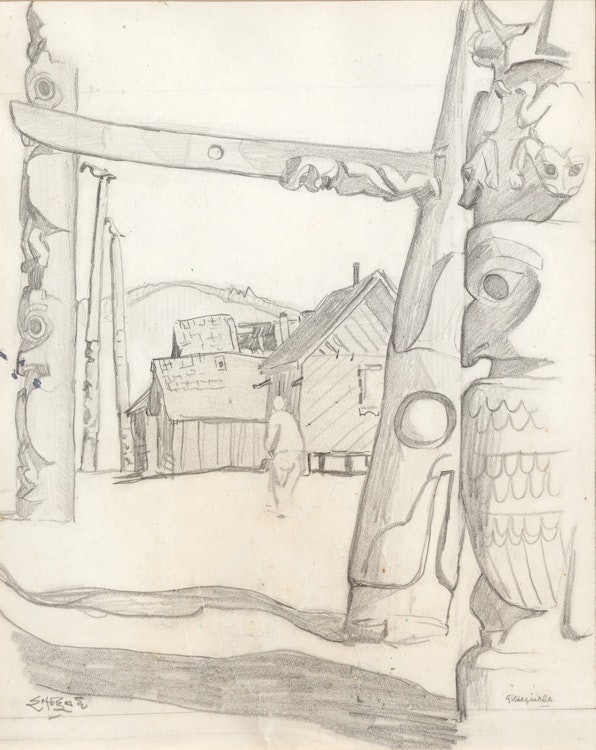Totem Poles, Gitsegukla by Edwin Headley Holgate

Edwin Holgate
Totem Poles, Gitsegukla
graphite drawing
signed lower left, inscribed “Gitsegukla” lower right
9.5 x 8 ins ( 24.1 x 20.3 cms )
Auction Estimate: $15,000.00 - $20,000.00
Price Realized $20,400.00
Sale date: December 1st 2022
Framing Gallery, Toronto, 1965
Private Collection
“Edwin Holgate”, Montreal Museum of Fine Arts; traveling to Glenbow Museum, Calgary; McMichael Canadian Art Collection, Kleinburg; National Gallery of Canada, Ottawa and Beaverbrook Art Gallery, Fredericton, 26 May 2005–15 April 2007, no. 53
Sandra Dyck, “‘A New Country for Canadian Art’: Edwin Holgate and Marius Barbeau in Gitxsan Territory,” in Rosalind Pepall and Brian Foss, “Edwin Holgate”, Montreal, 2005, reproduced page 56
Holgate and Jackson spent six weeks traversing the territory. During that time, and in the coming months, Holgate produced several portrait and figure drawings, oil sketches, wood engravings, and at least two canvases: “Indian Grave Houses” (1926, private collection) and “Totem Poles, Gitsegukla” (1927, National Gallery of Canada). Thirteen of these pieces, among them the 1927 canvas, were included in the major exhibition “Canadian West Coast Art, Native and Modern”, at the National Gallery in December 1927.
The five poles as depicted in the drawing “Totem Poles, Gitsegukla” show little wear from age and weather, compared to the more physically degraded poles seen in period photographs. In this and other respects the drawing and the canvas are closely similar, especially as both employ taut compositions that position the poles’ five towering verticals and one dramatic horizontal to frame the middle‒ground buildings and lone female figure. There are also differences, however, and these are key to understanding Holgate’s working method. He adjusted his initial conception so as to enhance the scene’s solemn, crepuscular atmosphere through the addition of more complex shadows and a sleeping dog. Other changes framed and focused the view more tightly. Narrow strips at the top, bottom and right‒hand side of the drawing were eliminated, increasing the intimacy of the scene. More striking is the transformation of the drawing’s single hill into a pair of forested hills extending beyond the left‒hand edge of the drawing, and the addition of a row of stark mountains. These may well include the Segukla peak, from which the name of the village was derived. The mountains and the leftward extension of the hills decisively close off the view beyond the village itself, heightening the scene’s atmosphere of silent intimacy.
We extend our thanks to Brian Foss, Carleton University Professor of Art & Architectural History, and co‒curator of “1920s Modernism in Montreal: The Beaver Hall Group” for his assistance in researching this artwork and for contributing the preceding essay.
Share this item with your friends
Edwin Headley Holgate
(1892 - 1977) Group of Seven, Canadian Group of Painters, Beaver Hall Group, RCA
Edwin Holgate was born in Allandale, Ontario. Holgate began his art education at the Art Association of Montreal studying under William Brymner who was also A.Y. Jackson's teacher. In 1912 he went to Paris where he studied at the Académie de la Grande Chaumière under Claudio Castelucho and later under Lucien Simon and René Ménard. He was in Russia at the outbreak of the First World War. He returned to Canada where he enlisted and served with the 5th Canadian Division Artillery in France (1916-19). He married Mary Frances Rittenhouse in 1920 and returned to Paris where he continued his studies. There he attended the Colarossi under Adolph Milman, a Russian refugee.
He returned with his wife to Canada in 1922 and opened a studio. He taught wood engraving at the Ecole des Beaux Arts for six years. In Montreal he enjoyed the friendship of A.Y. Jackson, Clarence Gagnon, Mabel May, Lilas Newton, Randolph Hewton, and many of the younger artists who became known as the Beaver Hall Hill Group. Holgate was a good skier and he would take trips to various parts of Quebec to sketch during the winters, sometimes at Baie St. Paul where A.Y. Jackson, Clarence Gagnon, Mabel May and others would congregate.
In 1926 he accompanied A.Y. Jackson and Marius Barbeau to the Skeena River area in British Columbia. Barbeau had been investigating the condition of the Indian totem poles, many of which were restored by the C.N.R. engineer Mr. T.B. Campbell. Holgate and Jackson made a number of sketches of the poles and the Indian villages in the area. From his sketches, Holgate made several large canvases. One is in the collection of the National Gallery and entitled is “Totem Poles, Gitsegiuklas”.
Holgate became the eighth member of the Group of Seven in 1931 and remained a member of the Group until it disbanded in 1933. From it arose the Canadian Group of Painters of which he was a founding member. Paul Duval noted that Holgate and Varley were the only members of the Group who drew and painted nudes. Holgate was well known also for his portraits and did many striking character studies of inhabitants of Canadian bush country. The Art Gallery of Ontario and the National Gallery of Canada have his nude studies in their collections.
During the Second World War, Holgate served overseas as an official Canadian war artist with the R.C.A.F. and painted mainly portraits of flying officers. Holgate’s wood-engravings are exceptionally well done and interesting. He was a member of the Royal Canadian Academy (A.R.C.A. 1934 - R.C.A. 1935). His work has been exhibited in many group shows over the years. He is represented in many collections including the National Gallery of Canada, the Art Gallery of Ontario, the Art Gallery of Hamilton and the McMichael Collection.
Source: "A Dictionary of Canadian Artists, Volume II”, compiled by Colin S. MacDonald, Canadian Paperbacks Publishing Ltd, Ottawa, 1979

